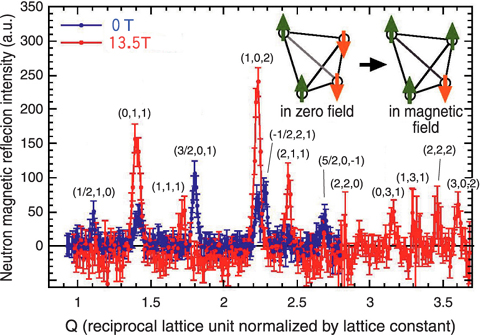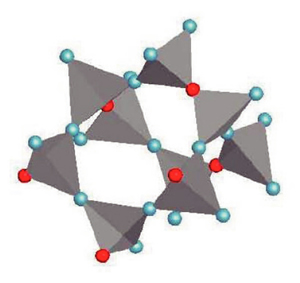
Fig.4-12

Fig.4-13
In the spinel antiferromagnet ACr2O4 (A: non-magnetic elements), the magnetic Cr3+ ions form the most frustrated lattice, a three-dimensional network of corner-sharing tetrahedra, a so-called "pyroclore lattice" . Furthermore, since Cr3+ has no orbital degree of freedom, the Jahn-Teller distortion is not expected and a highly symmetric cubic structure is maintained. As a result, it is predicted that magnetic ordering is suppressed down to very low temperatures due to the strong magnetic frustration. However, in real materials, a long-range magnetic ordering appears at a very low temperature, accompanying a structural distortion. This is an interesting phenomenon called "spin Jahn-Teller effect" , originating from strong spin-lattice coupling. This phenomenon is related to the spin-Peierls transition in the quantum spin system, at which spin dimers are induced by a structural distortion, and is also related to functional multiferroics, in which (anti)ferromagnetism and (anti)ferroelectricity coexist.
Another interesting phenomenon in ACr2O4 is that a magnetization plateau is observed in a wide range of magnetic field. Theoretical studies predicted that the magnetization plateau is stabilized with strong spin-lattice coupling. However, experimental studies to determine the crystal and magnetic structures in the plateau phase have not been performed yet. We performed neutron and X-ray diffraction measurements in HgCr2O4 , which has a magnetization plateau phase above ~10 T, to elucidate the spin-lattice coupling in this interesting system.
We first performed neutron diffraction experiments in zero magnetic field at the JRR-3 facility and determined the magnetic structure. Fig.4-12 shows the typical neutron magnetic diffraction patterns at 0 and 13.5 T. With increase in the magnetic field, the neutron magnetic diffraction pattern changes at around 10 T, indicating that the magnetic structure changes dramatically. Although there were several possible magnetic structures in the plateau phase, we determined the magnetic structure uniquely, as shown in Fig.4-13, from magnetic structural analysis. Three spins out of four in one tetrahedron point in the direction of the magnetic field and one spin points opposite to the magnetic field. We also performed X-ray diffraction experiments under magnetic field at the SPring-8 facility and found that the crystal structure also changes in the plateau phase. Most importantly, the symmetry of the crystal structure is exactly the same as that of the magnetic structure, indicating that the structural distortion stabilizes the magnetic structure. Therefore, the spin-lattice coupling influences greatly not only the transition at zero field but also the field-induced transition. We clarified this important mechanism experimentally for the first time.